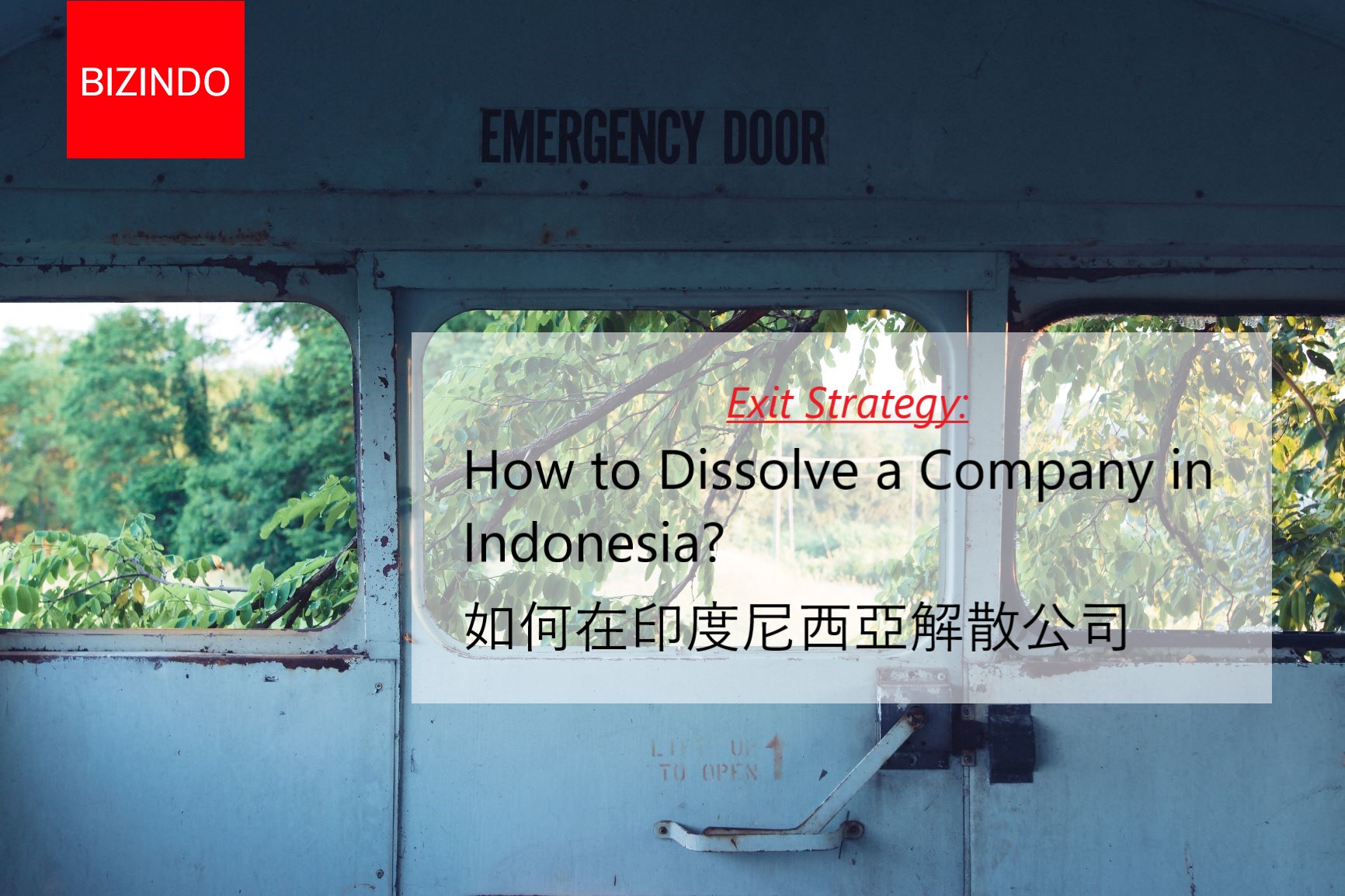The general principle on dissolution of Limited Liability Company is stipulated under Article 143 paragraph (1) of Law No. 40 of 2007 regarding Limited Liability Company, which provides that the dissolution of company does not automatically erase the legal status of the company. The legal status would be lost at the end of the liquidation process and accountability of liquidator has been accepted by the General Meeting of Shareholder or District Court.
Article 142 of Company Law elaborates that a company can be dissolute based on the following occurrence:
- Based on the resolution of General Meeting of Shareholder;
- Due to the termination of the company’s duration as stipulated in the articles of association;
- Based on the court order;
- Due to the revoked bankruptcy statement based on binding order of the commercial court, and the bankrupt assets of the company is not sufficient to pay the bankruptcy cost;
- Due to the condition that the bankrupt assets of the company has been declared in the condition of insolvency as regulated in the Law regarding Bankruptcy and the Suspension of Debt Payment; or
- Due to the revocation of the company’s business permit, so that the company is obliged to conduct liquidation in accordance with prevailing regulation.
Further elaboration on the conditions in point (1) and (2) above are as follows:
a. Dissolution Based on the Resolution of General Meeting of Shareholder
Article 144 of the Company Law provides that the General Meeting of Shareholder concerning dissolution can be held based on the proposal from the Board of Directors, Board of Commissioners or 1 (one) or more shareholder representing at least 1/10 (one-tenth) from the total number of shares with voting right. Moreover, the General Meeting of Shareholders’ resolution regarding the Company’s dissolution shall be valid if it is taken by mutual consensus or if it is approved by at least 3/4 (three-fourth) of the total shares issued with voting rights are present or represented, except articles of association stipulates a higher quorum and/or a provision regarding the adoption of resolution in the General Meeting of Shareholders.
b. Dissolution Based on Court Order
Article 146 of the Company Law provides that Dissolution based on District Court Order can be based on request from:
- Prosecutor’s office, based on the reason that the Company has violated the public interest or the Company has committed an action that which violating the regulation;
- relevant party, based on the reason that the deed of establishment is found to be defect;
- Shareholders, Board of Directors, or the Board of Commissioners, based on the reason that it is no longer possible to run the Company.
It should be noted further that the in the event that the Court order determines that the Company shall be dissolute, the Court will then appoint a liquidator to handle the process of liquidation.
Procedures and Mechanism of Dissolution of the Company:
As explained above, dissolution requires a resolution from the General Meeting of Shareholders. In order to do so, Article 79 (2), Article 82 and Article 144 (1) of Company Law provides that the Board of Directors, Board of Commissioners or 1 (one) or more shareholder of the Company who representing at least 1/10 (one-tenth) from the total number of shares with voting right may submit a request concerning dissolution and the appointment of liquidator(s) to General Meeting of Shareholders of the Company.
The General Meeting of Shareholders, in such agenda, is valid if it is attended by shareholders who representing at least ¾ (three-quarters) of shares with valid voting rights. In this vein, resolution of General Meeting of Shareholders is validly adopted if such resolution is approved by at least ¾ (three-quarters) of the total votes legally cast at the General Meeting of Shareholders. This is clearly enshrined by Article 89 (1) of Company Law.
Pursuant to Article 144 (3) of Company Law, dissolution process starts and effective since the date mentioned on the General Meeting of Shareholders’ resolution or if such resolution does not expressly stated the date of dissolution process, the dissolution process is effective as of the date of the General Meeting of Shareholders’ resolution.
Dissolution shall be followed by liquidation process which is conducted by one or more liquidator(s). This is provided by Article 142 (2) point (a) of Company Law. If the General Meeting of Shareholders does not appoint a liquidator, therefore in accordance with Article 142 (3) of Company Law, the Board of Directors of the Company shall act as liquidator.
Pursuant to Article 147 (1) of the Company Law, the liquidator within 30 (thirty) days since the effective date of the dissolution shall notify:
1) All creditors concerning the dissolution by means of announcement of dissolution in a newspaper and State Gazette of the Republic of Indonesia; and
2) the dissolution of the Company to Minister of Law and Human Rights (“MOLHR”) to be recorded in the Company Registry that the Company is in liquidation.
The announcement as provided above must at least contain:
1) the reason and legal basis of dissolution;
2) the liquidator’s name and address;
3) the procedure for the submission of claims; and
4) the period for submission of claims.
Article 147 (3) of Company Law provides that all creditors may submit their claims within a period of 60 (sixty) days calculated since the date of announcement.
Based on Article 149 (1) of Company Law, the obligation of the liquidator in settling the assets of the Company in liquidation process shall be as follows:
1) recording and collecting the assets and debts of the Company;
2) announcement in a newspaper and State Gazette of the Republic of Indonesia with regard to the plan of distribution of assets resulting from the liquidation of the Company;
3) payment to all creditors;
4) payment of the remaining assets resulting from the liquidation to the shareholders;
5) other actions necessary in the settlement of assets of the Company.
The Company Law is silent in regards to the period of liquidation process as stated in Article 149 (1) of Company Law. However, Article 149 (3) of Company Law regulates that the period for creditors to submit an objection to the plan of distribution of assets is 60 (sixty) days from the announcement date.
The General Meeting of Shareholders concerning approval of liquidator’s duty shall be convened after all steps above is already conducted and completed by the liquidator. In this vein, if the General Meeting of Shareholders grants the liquidator an acquittal and discharge, then according to Article 152 of the Company Law, the liquidator must report to the MOLHR and announce the final outcome on the liquidation process in a newspaper at least 30 (thirty) days counting from the date of the General Meeting of Shareholders which approving the liquidator’s duty. Subsequently, MOLHR will register and delete the Company’s name from the Company Registry and will announce it in State Gazette of the Republic of Indonesia. The Company Law is silent concerning the period of such deletion and announcement process.
The Estimated Time Frame on Dissolution Process:
Based on the steps to above, we estimate that the dissolution process will take at least 12 (twelve) months from the date of approval of General Meeting of Shareholders. This is with the assumption that during such period of time, all rights and obligations (i.e. claims and account receivables) of the Company to third parties are settled.
For your information, the process of dissolution and liquidation of a company may be divided into the following stages:
The Board of Directors (“BOD”) of the Company shall hold a meeting to adopt a resolution of proposing the shareholders of the Company to dissolve and liquidate the Company due to a reasonable reason.
Extraordinary General Meeting of Shareholders (“EGM”) must be held to approve the liquidation which must be at least attended by ¾ (three fourths) of the total issued shares and approved by at least ¾ (three fourths) of all votes cast.
The following are notifications to authorities to be submitted no later than 30 (thirty) days after the adoption of the EGM liquidation resolution:
a. Announce the liquidation in 2 (two) daily newspapers and the State Gazette of the Republic of Indonesia;
b. Notify the Ministry of Justice;
c. Register the liquidation resolution with the Company Registry of the Ministry of Trade;
d. Request to the Capital Investment Coordination Board (“BKPM”) to revoke the investment approval.
Notify all the Company’s creditors (if any) of the Company’s liquidation.
Notify the Tax Office of the liquidation and request for revocation of the Company’s Tax Registration Code (NPWP).
The second EGM shall be held to approve the liquidation report prepared by the liquidator, which then fully release the liquidator from his responsibilities.
Register the closing of the liquidation of the Company with the Company Registry of the Ministry of Trade, Ministry of Justice, and announce the same in the State Gazette and 2 (two) daily newspapers.
Get a Quote to Dissolve Company in Indonesia
Kindly fill in the form below, our consultant will get in touch as soonest.
Alternatively you can call at +62 815 629 0000 or email to [email protected]





 20% off today. Whatsapp us!
20% off today. Whatsapp us!